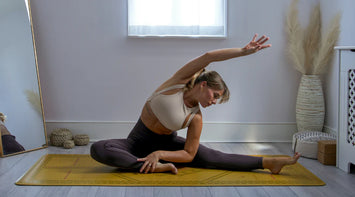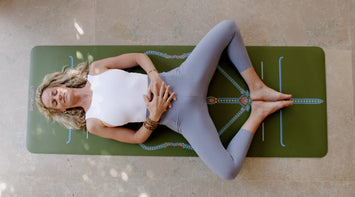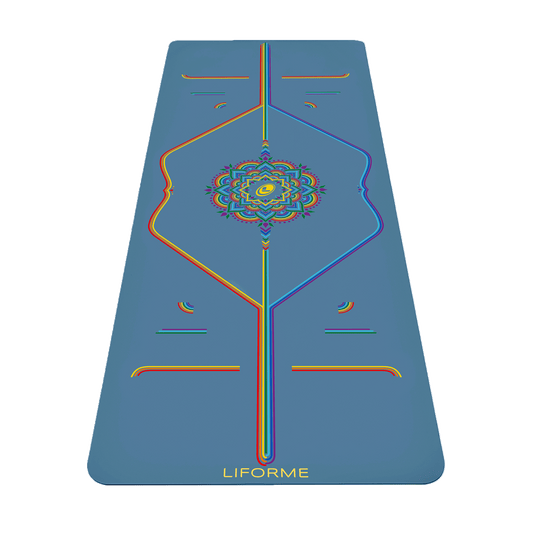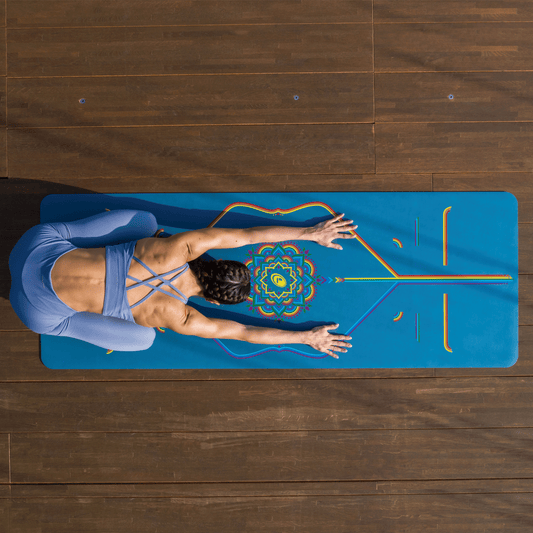The Story of Liforme’s Truly Eco-Friendly Yoga Mat and Our Commitment to Saving the Earth
When Liforme founder James Armitage set out on his journey to make an exceptional yoga mat, he did not initially anticipate the extent to which environmentalism would become one of the major cornerstones of our company’s business. His original intention was to make a high-performance mat that would stay grippy under the sweatiest conditions. He expected the mat’s calling card to be the distinctive alignment graphic on its surface, designed to be visually appealing as well as properly functional and flexible enough to work with all different kinds of bodies and yoga practices.
 But as research and development got underway, it quickly became clear that something was seriously wrong with the way most yoga mats were being made. The majority of mass-market yoga mats, as well as some of the highest-end mats, are made out of polyvinyl chloride, commonly known as PVC. This material, while cheap, presents a lot of issues for the Earth’s environment, comes with question marks about toxicity, and, frankly, doesn’t even make a very good practice surface for yoga in the first place. To build a better yoga mat (for both yogis and the planet), it was necessary to put aside the way the most mats had been produced to date and start over from scratch.
But as research and development got underway, it quickly became clear that something was seriously wrong with the way most yoga mats were being made. The majority of mass-market yoga mats, as well as some of the highest-end mats, are made out of polyvinyl chloride, commonly known as PVC. This material, while cheap, presents a lot of issues for the Earth’s environment, comes with question marks about toxicity, and, frankly, doesn’t even make a very good practice surface for yoga in the first place. To build a better yoga mat (for both yogis and the planet), it was necessary to put aside the way the most mats had been produced to date and start over from scratch.
What’s So Wrong With PVC?

The problems with PVC as a material for yoga mats start with its lack of basic functionality for this purpose and continues into serious environmental concerns about what happens after these mats’ use-life is over and they are thrown ‘away’.
Low-cost PVC mats provide a barrier between a yogi and the floor (at least until they develop gaping holes), and that’s about it. They don’t offer much in the way of cushioning, stability, or grip, and they quickly wear out, sending them straight on to landfills where, astonishingly, it may take hundreds or even thousands of years for them to break down completely.
Higher-end PVC mats are often more resilient and don’t shred as easily so they will last longer, but there are other reasons why they still get thrown out. If their surface layer is damaged by something sharp (even a wily toe-nail can do it!), for example, then sweat, dirt, and bacteria can get into the underlying foam layer and produce a bad smell that’s impossible to clean away.
As you might expect, these harder and tougher PVC mats are even less degradable, so they may take even longer break down in landfills. And if PVC mats are ever disposed of by incineration, the results are even more frightening since burning PVC produces dioxins, which are some of the most toxic chemicals to humans.
Adding to their list of ecological offences, PVC mats generally have what is called a ‘closed-cell’ surface, which is non-absorbent. That’s why they get so slippery when the perspiration starts to flow during intense asana sessions. This flaw has resulted in the widespread use of auxiliary mat towels to soak up the sweat. These towels require frequent washing, which means water waste and detergent pollution are also brought into the mix.
PVC’s resistance to degradation means that just about every yoga mat ever made from it is still sitting in a landfill somewhere. That’s a pretty significant environmental issue and one that their manufacturers would prefer that you didn’t think about.
Building a Better Mat
Liforme’s original mission to offer yogis a better practice surface soon broadened to include environmental stewardship as one of the most important aspects of our development of a new and improved version of the yoga mat. It became an integral part of building our supplier relationships, our production processes, our packaging solutions and, well, our whole company really.
Liforme mats are made from natural rubber (a renewable resource) and a unique and proprietary specially engineered form of polyurethane (our top surface) that is completely biodegradable within approximately one to five years in normal landfill conditions.
(To learn more about the important differences between PVC and polyurethane, please read the report we commissioned from independent researchers at Imperial College London, comparing the manufacture, use, and disposal of PVC and Liforme mats.)

Our revolutionary top surface offers incredible grip and traction, eliminating the need for mat towels. We pioneered a process of heat binding the two layers that avoids chemical adhesives and we use no plastic wrapping in our packaging, right the way through from the factory to the end yogi-customer (that’s you!).
Of course, we also stayed true to our original goal of giving yogis a better practice experience. Liforme mats are longer and wider than standard yoga mats so you never feel limited and our Align-for-Me graphic expands the functionality of what a mat can do for beginners and advanced practitioners alike.
If you are used to sending up a shower of mat shreds every time you step forward from Downward Facing Dog or get frustrated with working on your Warrior II on a hard, slippery surface, a Liforme mat is going to be a revelation for you. And you can practice secure in the knowledge that after a good run as your most dependable yoga companion, your mat will not end up clogging a landfill until the end of time.
It’s actually a pretty simple equation:
better practice experience + better ecological outcome = better mat.
Earth-Friendly
Once we found out about the ecological hazards the yoga mat industry perpetrates, we became committed to not only doing our utmost to ensure our mats are made the right way, but also to supporting the important work that environmental organisations are doing throughout the world. We want to do whatever we can to help to stop practices that harm the planet and to change the outlook on conservation before it’s too late because we believe that to be a yogi is to be an environmentalist.

To this end, we have partnered with Friends of the Earth, a leading environmental conservation charity, which has a powerful network that includes 74 countries and all 50 US states. We are extremely proud to be able to support their amazing, truly important work by a percentage from each sale of our Purple Earth mats. Friends of the Earth focuses on grassroots actions, like their Plastic-Free Fridays campaign, and on lobbying for legislative solutions to our climate and pollution crises. They were instrumental in bringing universal access to household recycling to the UK and in banning pesticides that harm bees throughout the EU.
Friends of the Earth’s local to global approach fits right in with how yoga works on the body and mind, encouraging us to embrace transformation for ourselves and our communities. Once we see that we have the power to enact change, why stop at the borders of our bodies? Why not change the world?
We are also partnered with Tree-Nation to plant hundreds of thousands of oxygen-producing trees in places where they can to the most good and with the WWF to protect the habitats of threatened species. In 2022, we proudly became a Certified B Corp, joining a community of like-minded companies committed to doing better.
When you choose a Liforme mat, you are supporting innovation, the environment, social justice, wildlife preservation, and corporate ethics, because that’s the way we do business.






































